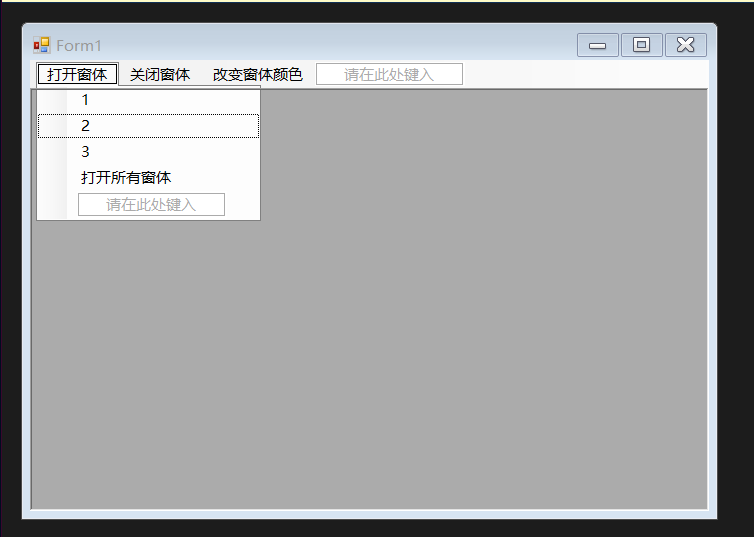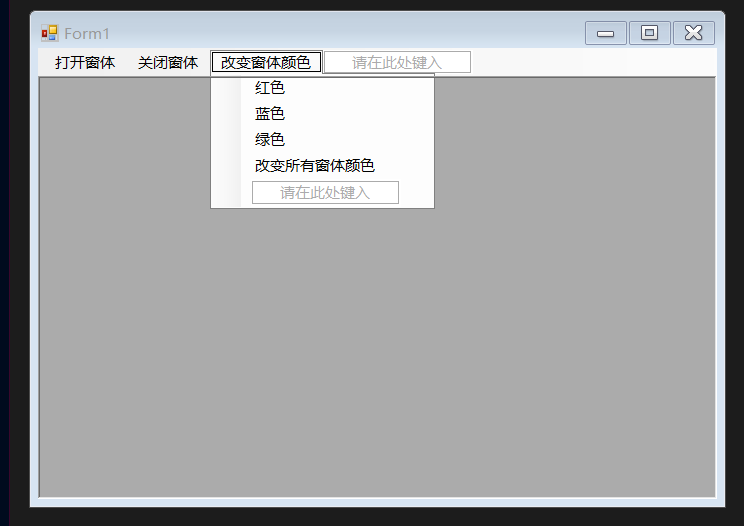如何让打开的mdi子窗体对应改变颜色
该问题来自社区帖: https://bbs.csdn.net/topics/616030101.为符合问答规范, 该问题经过ChatGPT优化
换肤功能实现问题 如何让打开的mdi子窗体对应改变颜色?我已设置三种颜色,每个子窗体都应该能修改三种颜色。以下为实际效果图:
换肤功能实现问题 如何让打开的mdi子窗体对应改变颜色?我已设置三种颜色,每个子窗体都应该能修改三种颜色。以下为实际效果图:


在Java Swing中,要实现打开的MDI子窗体对应改变颜色,可以在所有子窗体的构造函数中注册监听器,然后在父窗体的activeChildChanged()方法中根据当前激活子窗体的不同,设置子窗体的颜色。
下面是一个示例程序,演示如何实现在MDI主窗体中切换子窗体并改变其颜色。在这个示例程序中,我们创建了3个子窗体,并为每个子窗体设置了不同的背景颜色。当切换到新的子窗体时,它的颜色将更改为红色,其他子窗体的颜色将更改为灰色。
import javax.swing.*;
import java.awt.*;
import java.awt.event.*;
public class MDIFrame extends JFrame implements ActionListener {
private JDesktopPane desktopPane = new JDesktopPane();
public MDIFrame() {
super("MDI Frame");
setDefaultCloseOperation(JFrame.EXIT_ON_CLOSE);
// 创建多个子窗体
createFrame(Color.RED);
createFrame(Color.GRAY);
createFrame(Color.GRAY);
// 设置ContentPane并注册监听器
setContentPane(desktopPane);
desktopPane.addVetoableChangeListener(JInternalFrame.ACTIVATED_CHANGED_PROPERTY, this);
// 初始化界面
setLocationRelativeTo(null);
setSize(640, 480);
setVisible(true);
}
// 创建子窗体
public void createFrame(Color color) {
JInternalFrame frame = new JInternalFrame();
frame.setBackground(color);
frame.setDefaultCloseOperation(JFrame.DISPOSE_ON_CLOSE);
frame.setSize(200, 200);
frame.setLocation((int) (Math.random() * (getWidth() - frame.getWidth())),
(int) (Math.random() * (getHeight() - frame.getHeight())));
frame.setVisible(true);
desktopPane.add(frame);
}
// 监听器实现
public void actionPerformed(ActionEvent e) {
JInternalFrame[] frames = desktopPane.getAllFrames();
for (int i = 0; i < frames.length; i++) {
if (frames[i].isSelected()) {
frames[i].setBackground(Color.RED);
} else {
frames[i].setBackground(Color.GRAY);
}
}
}
// 切换子窗体
public void activeChildChanged() {
JInternalFrame[] frames = desktopPane.getAllFrames();
for (int i = 0; i < frames.length; i++) {
if (frames[i].isSelected()) {
frames[i].setBackground(Color.RED);
} else {
frames[i].setBackground(Color.GRAY);
}
}
}
// 主方法
public static void main(String[] args) {
new MDIFrame();
}
}
在上面的示例程序中,我们首先创建了一个JDesktopPane,并在其中创建了3个子窗体,并为每个子窗体设置了不同的背景颜色。然后,我们为JDesktopPane注册了一个侦听器,以便在切换激活的子窗体时更新其颜色。
在activeChildChanged()方法中,我们首先获取所有的子窗体,然后遍历它们,并为当前被选中的子窗体设置为红色,其他子窗体设置为灰色。该方法会在MDI主窗体中的子窗体被选中时自动调用。
需要注意的是,我们使用JInternalFrame的setBackground()方法来设置子窗体的颜色,而不是使用JFrame的setBackground()方法。这是因为JInternalFrame是特殊的JPanel,用于在MDI主窗体中创建子窗体。